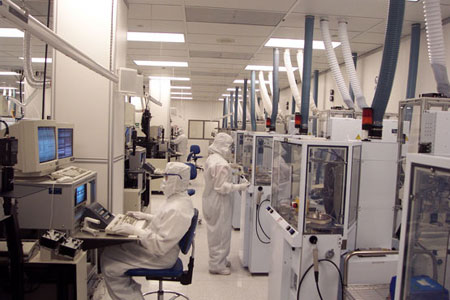Making GeneChips™ at Affymetrix

Affymetrix, the makers of GeneChip arrays. GeneChips help scientists identify genetic variations associated with diseases such as cancer. This information can be used to develop better methods for diagnosis and treatment. What you see here is the GeneChip production facility. GeneChips consist of hundreds of thousands of different DNA probes printed on quartz wafers. To assemble these probes on wafers, technicians alternate between a special printing process called photolithography and DNA synthesis. Here, photolithography is done on the left, and DNA synthesis is done on the right.
Genechip image 1
Welcome to Affymetrix, the makers of GeneChip arrays! GeneChips help scientists identify genetic variations associated with diseases such as cancer. This information can be used to develop better methods for diagnosis and treatment. What you see here is the GeneChip production facility. GeneChips consist of hundreds of thousands of different DNA probes printed on quartz wafers. To assemble these probes on wafers, technicians alternate between a special printing process called photolithography and DNA synthesis. Here, photolithography is done on the left, and DNA synthesis is done on the right.
quartz wafers,dna probes,dna synthesis,genetic variations,photolithography,printing process,arrays,hundreds of thousands,diagnosis,diseases,scientists,cancer
- ID: 15661
- Source: DNALC.DNAi
Related Content
15662. Making GeneChips at Affymetrix
Here you can see a technician shuttling a quartz wafer (containing 50-400 GeneChips) between alternating photolithography and DNA synthesis steps.
15666. Making GeneChips® at Affymetrix
The quartz wafer is in the holding position on the DNA synthesizer. The wafer is moved to a vertical reaction vessel for the process of DNA chain elongation.
15665. Making GeneChips at Affymetrix
A technician loads a quartz wafer into the DNA synthesizer, where nucleotides will be added to selected sequences to build probes.
16736. Animation 36: Different genes are active in different kinds of cells.
Igor Dawid and Thomas Sargent explain how they developed subtractive mRNA hybrization to find genes expressed by different cell types. Pat Brown and Steve Fodor show how genomes can be screened with DNA arrays and GeneChips™
553. Whole Genome Association
Special techniques are used for screening each individual’s genome for millions of different SNPs. This kind of comparison is referred to as a genome-wide association study.
15051. How GeneChip was developed (Part II), Stephen Fodor
Stephen Fodor continues his discussion of the experiments that laid the groundwork for GeneChip technology.
16884. Genome Scans Pay Off
Scans of the entire human genome turn up genes involved in common diseases.
15038. Making a DNA microarray, Patrick Brown
Pat Brown discusses the early technology behind the microarray.
16756. Biography 36: Patrick Henry Brown (1954- )
Pat Brown changed the way genomes can be screened with DNA arrays.











